American Sabbatical 026: 10/3/96
Big Hole
10/3 to 10/5... DON’T EAT AT PAPA-T’S IN DILLON, WYOMING!
Your intrepid correspondent has been silenced by mal de highway,
otherwise known as chicken-fried steak at Papa-T’s. I’ll pick
up the trail in sequence, but you can imagine a personal geyser
erupting faithfully in the background.
We felt GREAT after a day’s R&R on the edge of the Yellowstone
Plateau and set off reasonably early headed north-east up the
Yellowstone Valley. (It’s hard to judge morning time by the light
out here. Ol’ Mother Sun doesn’t peek into the valleys until the
day is well underway, and then the light has a washed out quality
that doesn’t give a clue about the hour.) The rangeland in these
great upland basins looks like rich pasturage after the sage deserts
of Wyoming, and the big ranch houses with their clusters of corrals
and outbuildings, seem quite affluent.
|
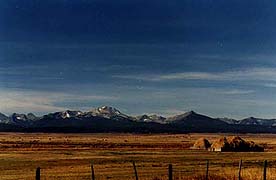
Hay Architecture
|
Somewhere in the Dakotas I stopped remarking on the architecture,
probably because it was trying to hide. The barns had turned into
quonset huts and the houses were lying low under the prairie winds.
You realize that the ranch house fits the plains landscape, and
all those misplaced “ranch” bungalows in New England may be just
someone’s dream of the wild frontier, where you keep your head
down. But over in western Montana the barns stand back up in bold
Dutch lines, and the log houses, old and new, rule. Despite the
look of affluence, however, the locals say that ranching doesn’t
pay. The price of cattle hasn’t recovered from a steep fall in
the 70’s. That may be just like the lobstermen saying the fishing
is poorly, though.
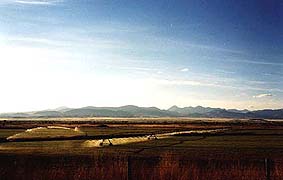
Broadcasting
|
We cruised up the valley between the Absarokas and the Gallatin
Mountains, surfing the FM and admiring the hay art. You can tell
that Montana is full of them Liberals, cause every other hop on
the scanner is NPR. Back on the plains it was solid Garth Brooks.
There were even spots in the Dakotas where FM scanning was a desert
of rolling digits. I’d forgotten that AM radio was the longhaulers’
medium of choice, and we listened to sowbelly future prices on
the long hop out of Omaha, while deep in Wyoming. It was a jolt
to be back in FM-land with the Stanbergs and the Keillors, and
I jumped back to the AM where real ‘Mericans know that Clinton
isn’t the answer. |
Then it was a long climb west over the Bridger Range, through
the Bozeman Pass, and a flying descent into the valley of the
Gallatin.. and the smutch over Bozeman. Out here in the Big Sky
Country we encountered our first visible air pollution. Inversions
over mountain valleys, a return to civilization.
| We had been told not to miss the Museum of the Rocky Mountains,
and despite our increasing museumitis, we dutifully navigated
to the University. These Western campuses sprawl over the turf,
and there’s no way you could get around them without a car. Hence
the smutch. Academic exhalations. The museum, another brand-new
building, was hardby a new sub-division of oversized ranchettes,
all stained-wood and glass walls. Home of the assistant professors,
no doubt. |

Montana Skyline
|
Inside was an up-to-the-minute kinetic display of the geotechtonics
of the mountains, and lots of hands-on exhibits for the dinosaur
lover. The one about coprolites didn’t grab me. Here I’d made
a long noise about wanting a quick course in geology, and the
state of Montana was obliging me with an interactive elementary
exposition deluxe. Sad to say, the splendid Disney-style dioramas
left me just as ignorant as usual. I did read through the intro
chapters in the Roadside Geology of Montana in the bookstore,
which helped some, but I couldn’t seem to come to grips with the
essence of these mountains through textual science, either.
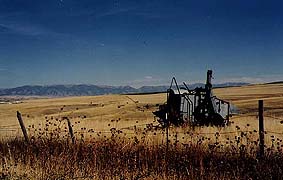
High Country Harvester
|
The long drive across the plains had thinned out the human resonances,
as the land had risen. Now traveling north along the great divide
the landforms dominate consciousness, overwhelm sketchbook esthetics,
and leave me struggling for a sense of intuitive understanding.
And the mountains stand back from you. The paved roads hug the
watersheds or cross over the saddles or through the gaps between
ranges. Clothed with black pines or snow-capped and bare, they
are an inescapable presence, always looming large behind the human-scale
artifice. But what are they? Would it help to know they are thrust-faulted
Precambrian sedimentaries with granitic intrusions? |
We took our orogenic obscurities downtown to hunt for a pot-boiler
and lunch. Bozeman is a funny mix of cowboy boots and hats with
tweed jackets and birkenstocks. It must be a little schizzy to
try and be wide open and stuffy in the same glance. The storekeepers
have figured out how to deal with the cowboy academic, though:
over-charge. Peggy was looking for a secondhand thriller to compete
with motel TV. In Bozemen, books are status items, and you couldn’t
get an old Kellerman for much less than its cover price. We shouldn’t
complain, I guess. We hadn’t been able to find a book STORE for
the last couple of weeks. After nosing the emporia on the main
drag, I suggested SallyAnn, and sure enough, we came away with
two trashy mindnummers for a buck. The clothes at the Salvation
Army, I might add, were sorry-looking castoffs. Maine has it all
over Wyoming in the secondhand dept.
In the food category, Bozeman was five-star for us. The Azteka
serves the best “Spanish” (Mexican-American) chow north of Santa
Barbara. A hole-in-the-wall place, it was packed at 2:30PM, and
we soon found out why. Yankee-Mex, for me, has always been tongue-torture
with the risk of bellyache, so I risked Azteka with some doubts.
We were wowed. Everything was from scratch, tender and toothsome,
and the price was modest. Maybe I should suspend judgment on Bozeman.
Even so, I was glad to put the smutch and the earnestness to stern.
| I had come away with an indulgent purchase for the road, myself.
I’d been trying to lay hands on one of Ian Tyson’s cowboy albums
since we left the Midwest, and finally found one in Bozeman. Ian
and Sylvia apparently split up the act back in the dark ages,
and Ian went ranching. He’s been writing and producing western
music for decades, but it has never crossed the cultural divide.
I’ve tried to match our background music to the visuals, and here
was a perfect pairing... high wide and handsome. We jacked Ian
into the squawkbox and fandangoed down the trail. There’s a gruff
edge to that sweet voice, now, and the mandolin picking sounds
like woodshedding (or is it haybarning here?), but it was perfect
for yodeling along. |
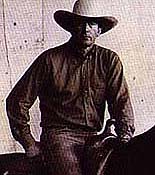
Ian Tyson
(From Album Photo)
|
But the interstate just doesn’t sing to me. We were aimed toward
Missoula, and the sister of a friend’s house. But we had two days
to get there, and the highroad was too swift. When Peggy spotted
the sign for Madison Buffalo Jump State Park, I wheeled her down
the ramp, over the cattle guard, and onto the gravel. Festiva
was going to gallop again.
Now you’ve got two choices when running the dirt, either you limp
along over the shuddering, and dodge the worst bits, or you nail
it and hope for the best. Going up the Granite River we had no
choice. There the bony bits were too high and often to run at
flank speed, but this was level ground.. so letter rip. Skidding
on the curves, pulling a thick plume, with the loose gravel thunking
underneath, it was like chasing a herd of buffalo at 40mph.
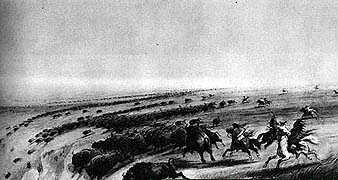
Buffalo Jump
(Alfred Jacob Miller)
|
The land had turned back into sear prairie grasslands broken by
limestone bluffs, falling suddenly to the west. Was this one the
jump? Or that one? Then we were there. The park parking sits on
a rise in a semicircle of bluffs surrounded by absolute stillness.
The map showed how the conformation of approaching prairie funneled
the driven bison to the height before us, and where there had
been eagle snaring pits dug into the bluff to our left. You had
to catch your eagle by hand, of course. What I caught at the buffalo
jump was a bit of the timeless silence. No thundering hooves,
no screaming eagles. Just sunwashed prairie and the rustle of
the grass. |
Then we were far enough down the dirt that we might as well gallop
on and see where it takes us. Where was the valley of the Madison
River where it cuts through the head of the Madison Range, and
we were completely taken. This is premier sport -fishing country,
and we began to see dories full of sports flailing away with flyrods.
Naturally they call these dories Something River boats, but they’s
dories, me son.
The rock cliffs intruding to the river’s edge were almost black,
and the contrast with the wheat-white grasses was stunning. We
were grinning widely as we yodeled back onto the hot-top. From
there we zigged and zagged until we hit Virginia City and mining
country. It’s a bit strange to snake down into these dessicated
wood towns with their stagefront facades and plank sidewalks,
assaying offices and town jails, only to find designer period
reproduction clothes in the millinery and outfitting establishments.
At least Virginia City seems to be a thriving ghost town. Maybe
that’s because there seem to be some active mines in the area.
All we saw of them was the devastation they’d wrecked on the river
bottom. Just a sea of boulders and gravel and choked willow tangles.
We considered malingering in Virginia City, checking out a B&B
in one of the old bordellos, but our burritos were settled nicely,
and we felt like a few more miles.
Big mistake. When we rolled into Dillon, it was to find one of
those gritty industrial burgs thrown up on a dusty flat without
even a near mountainscape to draw your eye. There was a wickedgood
display of cemented trash-art at the local junkatorium, with a
junkyard dog to match, and..greatest charm of all.. a Super8.
|
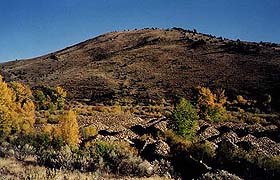
River after Goldmining
|
And Papa-T’s. It looked OK. There were bunches of rancher-types
crowding through the doorway, and we’d had such good luck in the
food line that day. Inside, Papa-T’s had all the ambiance of the
10-4 Diner in Liberty (Maine). Low, long and wide, with bare wood
floors and long wooden tables, a bar down one wall, and the jukebox
wailing. But this had it all over the 10-4. This was a Montana
Cuisino, with illumination by slot-machine and electronic blackjack.
Just the place to take Motha for a little sportin action at chow
time.
Two youngsters were hustling the eats at a dead run, serving maybe
50 head. The tables were slick with grease, and the wait staff
was shoveling the refuse onto the floor with their forearms between
servings. I mean it had charm. The menu had absolutely nothing
that your careful diabetic should come within a mile of. But,
what-the-hell, this is real man country. We’d been driving past
about a million big-macs on-the-hoof a day. Maybe it was a time
to loosen up and bite a bit of beef. And I’d never eaten chicken-fried
steak.
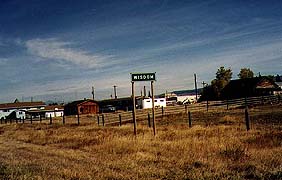
Could have used some
|
“On your head be it,” Peggy said, knowing it wouldn’t do any good
to chide me. Well, more like: on my shoe. It was a long night
in Dillon.
Sometimes you have to wound yourself to see behind things. Around
3AM, I was moaning for mercy and trying to scorch it out in a
tub of scaling water, when I began to get glimpses of the mystery
of the mountains. I’d heard of crying for a vision, and drumming
for a vision, taking hallucinogens, but eating chicken-fried steak....?
|
In that dissociated state I began to see figures in the landscape.
Vast shoulders and backs rising from the plains, immense hands
breaking through the fabric of earth, and bony fingers thrusting
up as pinnacles in the sky. I’d spent the last week trying to
fathom the depths of these mountains with a rational line, and
suddenly I was granted an anthromorphology of the hills. Do you
think Georgia Okeefe ate chicken-fried steak?
Friday was a long painful day. Peggy did most of the driving while
I hugged a pillow and groaned. We drove across Big Hole, land
of ten thousand haystacks, where the ranchers build mountains
of forage and fence them in until winter. We stopped in Big Hole
and walked the site of a battle between the Nez Perce and the
bluecoats, but I was too shot full of holes to appreciate it.
Like Lewis and Clark we had crossed and recrossed the continental
divide in our attempt to discover an historic path over America
(and had trouble with our rations). Now we ascended Chief Joseph
Pass, up out of the rich grasslands and back into the black lodgepoles
and ponderosas, then swooped down the steep slopes into the Valley
of the Bitterroot. We were back in the Columbia watershed, and
ready to move on. The staggering country looked as I’d imagined
Idaho does, and with good reason, Idaho was all of a mile away.
| Someone in the Montana Highway Department has a sense of humor.
The signs kept saying sixty-something miles to Missoula, for about
30 miles, and they kept stretching the road out in front of us.
When we finally stumbled onto Cynthia’s doorstep, all they could
do was pilot me to bed and cover me up. |
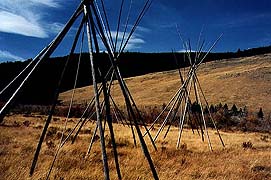
Tipis at Big Hole
|
(Memo #26)
Oct. 4 - Nez Perce War - Chief Joseph
Who? Chief Joseph of the Nez Perce and 750 members of his tribal
faction
What? flight of his group and battle with US Cavalry
Where ? Big Hole Valley, Southwest Montana
When? 1877
How? rancorous treaty negotiations created tribal factions and
one group (under Chief Joseph) fled the new reservation and were
pursued by cavalry
Topics: federal Indian policy, culture contact, culture clash,
Nez Perce, Chief Joseph
Questions: Was violence between Native Americans and white settlers
inevitable? Were there men of honor and peace who tried to prevent
violence? |
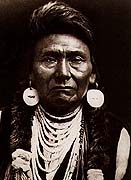
Chief Joseph
(Edward Curtis 1903)
|
For two days after we left Yellowstone we meandered through beautiful
southwest Montana. We stopped at the a buffalo kill site where
Native Americans ran herds off a cliff. All there was to see was
a beautiful cliff with grassy slopes sweeping up to i t. We drove
up the gorgeous Madison River with river fishermen working from
dories. Along the Tobacco Root mountains and then west again up
over a high pass to the Big Hole valley where mountain men would
spend the winters. We visited the site of the Battle of Big Hole
where US troops and Nez Perce Indians fought in 1877.
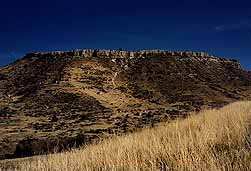
Scene at Buffalo Jump
|
“I recognize the fact that the Indian must yield to the white
man but power is not justice, force is not law.”
|
The Indians of the northern Rocky mountain areas - the Nez Perce,
Kootenai, Salish - had a mixed economy when the white man came.
They hunted buffalo and elk, collected berries and roots in their
mountains and valleys. They would regularly travel east to trade
with the Plains tribes. The Nez Perce were known for the horses
they carefully bred. The Nez Perce welcomed the first explorers
who would bring useful trade goods, they thought. They aided Lewis
and Clark on their travels and Marcus Whitman was sent out as
a missionary at the request of Nez Perce. (Their name is an inaccurate
French label since they never did use nose ornaments, and probably
comes from the sign language gesture used to identify the tribe).
There seems to have been initial goodwill and cooperation between
white settlers and the Nez Perce.
| Is it population pressure or flat greed that changes the balance
in culture contact situations? In the northern Rockies, it was
gold discoveries and the railroad’s extension that lead to white
demands for Indian land and for the removal of the Indian population
to reservations. The concept of preserving reservations for Indians
sounds logical IF the land was their ancestral land and IF their
rights were upheld. Neither of these conditions occurred very
often. |
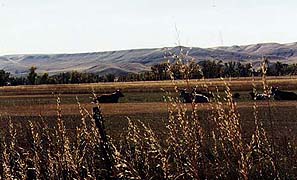
And then longhorns
|
A treaty was drawn up in 1855 that reserved thirteen million acres
of their original homelands for the Nez Perce. Then gold was discovered.
A second treaty was demanded by the whites in 1863 that was to
decrease Nez Perce lands by 90%. Fifty thousand dollars were offered
in compensation. Both treaties were backed by threats of white
violence if they weren’t accepted. The 1863 negotiations split
the tribe into two factions, those that supported the treaty and
those who didn’t. The treaty was put through despite the opposition
of a large number of Nez Perce. The war of 1877 came about when
the army finally got to work confining the Nez Perce to the smaller
1863 reservation. Tribal leaders asked for time to collect their
widespread stock; it was denied. During the forced removal, Nez
Perce killed a few whites that they said had cheated them. The
army moved in.
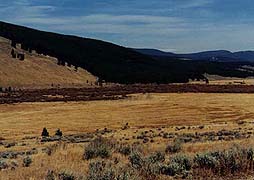
Big Hole
|
750 Nez Perce decided to flee the confinement and seek asylum
with other tribes to the east. They hoped to avoid war and said
repeatedly that they just wanted to be left alone. During this
circuitous 1,170 mile flight across Idaho, Wyoming and Montana,
Chief Joseph became the acknowledged leader. The army dogged their
steps and there were a series of small battles. |
In early August 1877 the fleeing bands had gotten across the Bitterroot
Mountains and camped in the Big Hole valley . Certain they had
outdistanced their pursuers, the Nez Perce posted no guards. An
army column moved in and attacked at dawn. Men, women, and child
were killed before the Nez Perce regrouped. The Indians counterattacked,
capturing the one large gun (which they dismantled) and keeping
the soldiers pinned down for over twenty-four hours as the bands
broke camp, and moved out. This was the Battle of the big Hole.
| The army followed the bands and the Nez Perce fought and fell
back and fought and fell back until Chief Joseph (with an eloquent
speech) surrendered, announcing that he would “fight no more forever”.
The bands were just fourteen miles from Canada. Many participants
- even army officers - questioned the government tactics in the
treatment of the Nez Perce. Could we/should we have just let them
go? |

Battle Site
|
The battlefield (which is, ironically, west of the town of Wisdom,
Montana) is a beautiful site. There is a small creek that winds
through grassy meadows at the foot of steep slopes. Willow thickets
grow along the watercourse. The nearby hillside was and is bare
of trees, but the farther slopes are heavily wooded. A small visitor
building is on a hill to the east. Guides show slides and movies
and a small collection of Army and Nez Perce artifacts (the canon
seized by the Nez Perce and Chief Joseph’s coat and some reproductions
of army gear). I was impressed by the balanced presentation and
the sensitivity to the claims of both sides in the battle. A balcony
shaped like an arrowhead overlooks the whole area. We drove down
to the meadows and followed a trail to the site of the Nez Perce
camp, walking for ten minutes through willow thickets and grass.
A second trail lead up to the hillside where the site the troops
fortified in defense can still be seen. Open tipis constructed
just of poles showed the large village by the creek. Small signs
identified the tipis’ owners. Small cutouts of army hats and feathers
were placed in the grass to show where bodies had been. The signs
were small and unobtrusive. I could put my back to the visitor
building and see no signs of the modern age. The wind and the
creek provided the only noise except for phantom yells and gunfire.
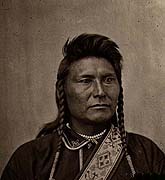
Chief Joseph
(1877)
|
“We took away their country and their means of support, broke
up their mode of living, their habits of life introduced disease
and decay among them and it was for this and against this they
made war. Could anyone expect less?” - General Philip Sheridan
“If the white man wants to live in peace with the Indian he can
live in peace. There need be no trouble. Treat all men alike.
Give them all the same law. Give them all an even chance to live
and grow...Whenever the white man treats the Indians as they treat
each other, then we shall have no more wars.. For this time the
Indian race are waiting and praying” - Chief Joseph
|













